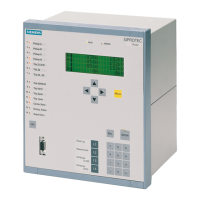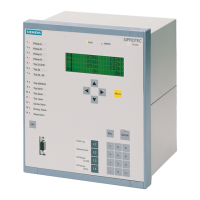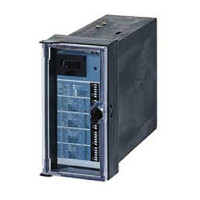2.7 Single-Phase Time Overcurrent Protection
201
7UT613/63x Manual
C53000-G1176-C160-2
Protection Functions“) and the properties of the 1-phase measuring inputs (section
2.1.4 under „Topology of the Protected Object“, margin heading „High-sensitive
1-phase Additional Measuring Inputs“).
• If you have declared the type of the corresponding 1-phase current input as (ad-
dress 255 and/or 256) as 1A/5A input, set the pickup value 1Phase I>> under
address 2702, the pickup value 1Phase I> under address 2705. If only one stage
is required, set the other to ∞.
• If you have declared the type of the corresponding 1-phase current input as (ad-
dress 255 and/or 256) as sensitiv input, set the pickup value 1Phase I>>
under address 2703, the pickup value 1Phase I> under address 2706. If only one
stage is required, set the other to ∞.
If you require a trip time delay, set it for the I>> stage at address 2704 T 1Phase
I>>, and for the I> stage at address 2707 T 1Phase I>. If no delay time required,
set time to 0 s.
The set times are pure delay times which do not include the inherent operating times
of the protection stages. If you set a time to ∞, the respective stage does not trip but
a pickup annunciation will be signalled.
A detailed description for the use as high-impedance protection and tank leakage pro-
tection is set out below.
Use as High-Imped-
ance Differential
Protection
When used as high-impedance protection, only the pickup value of the single-phase
overcurrent protection is set on the 7UT613/63x to detect overcurrent at the assigned
highly sensitive 1-phase current input.
However, the entire function of the high-impedance unit protection is dependent on the
coordination of the current transformer characteristics, the external resistor R and the
voltage across R. The following three header margins entail information with regard to
these considerations.
Current Transform-
er Data for High-Im-
pedance Protection
All current transformers must have identical transformation ratio and nearly equal
knee-point voltage. This is usually the case if they are of equal design and have iden-
tical rated data. If the saturation voltage is not stated, it can be approximately calcu-
lated from the rated data of a CT as follows:
U
S
Saturation voltage
R
i
Internal burden of the CT
P
N
Rated power of the CT
I
Nom
Secondary rated current of the current transformer
ALF Nominal accuracy limit factor of the current transformer
Rated current, rated power and accuracy limit factor are usually indicated on the rating
plate of the current transformer, e.g.
Current transformer 800/5; 5P10; 30 VA
That means
I
Nom
= 5 A (from 800/5)
n = 10 (from 5P10)
P
N
= 30 VA
